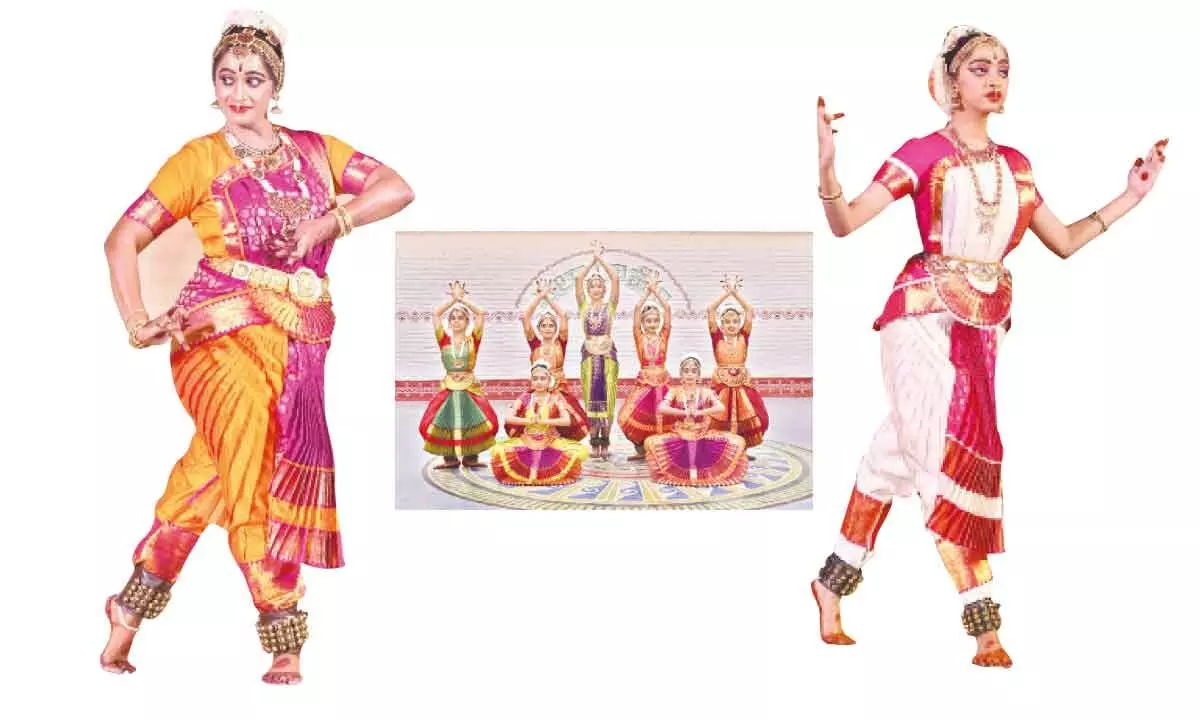Live
- Keralites gulp down liquor worth Rs 152 crore over Christmas period
- Nani exudes style & intensity in ‘HIT 3’ new poster
- Journalist-writer Dr Rentala Jayadeva comes with a book ‘Mana Cinema.. First Reel’
- Harish Rao Criticizes Government’s Delayed Response to Sandhya Theatre Incident
- Apple Watch Ultra 3 to Include BP Monitoring and Satellite Texting by 2025
- Youth expressed protest by flying drones over road issue
- Kamal Haasan pays tribute to Jnanpith awardee MT Vasudevan Nair
- Aadi Pinisetty’s ‘Shabdam’ locks release date
- AAP’s Ultimatum to Congress: Take Action Against Maken or Face Expulsion from I.N.D.I.A.
- Beware of Fake RBI Voicemails Scam: How to Stay Safe
Just In
Centenary celebrations: Sree Narayani Natyalaya honours Guru T K Narayan


Guru Santhosh Kumar Thamang orchestrated a mesmerizing performance at Shilparamam, commemorating the centenary of revered Guru Sri T K Narayan, showcasing the brilliance of his young students in Bharatanatyam
Guru Santhosh Kumar Thamang arranged a brilliant performance of his talented young students at Shilparamam on the weekend to mark the centenary of revered Guru Sri T K Narayan who had learnt Bharatanatyam from the legendary Meenakshi Sundaram Pillai. The music recording played was a highlight as the track was so clear it was similar to an Orchestra playing, and Guru Santhosh was on the nattuvangam thus supporting the illusion perfectly. Compere and dancer Nikhil Dev lucidly explained the import of the program that it was also the 12th anniversary of Sri Narayani Natyalaya, the traditional Bharatanatyam institute founded by Santhosh to keep alive the late Guru’s name. He ably compered the program by announcing the items, their ragam, and composer as they were done in sequence.
The Upanishads propound become God in order to worship God, and of all religious ceremonies, dance is considered the most pleasing form of worship. The pushpanjali is thus named as in worship also Flowers are first offered to the Deity as dances were often performed in Temples in ancient times. The first item in amruthavarshini ragam belonged to this genre. It was well executed by the students. Their colourful costumes made the stage attractive and come alive like a vivid mosaic.
Alarippu which literally means blooming like a Flower in chatusram followed. This is a small composition containing a lesser number of adavus which are like words in a paragraph so that it is easy for beginners to grasp before attempting more complex items. Composed of pure nritta, it is an invigorating warm-up for the dancer and the distinguishing feature is that it gradually exposes the audience to the full range of movements as an introduction. Michelle Jose gave an excellent example of dedication and focus when she presented the item.
The jathiswaram in kalyani composed by the Tanjore Quartet was triumphant in melody and the ragam which is a perennial favourite literally bloomed in the students group interpretation. Intervening korvais are characterized by elaborate movements and there is no sahityam or lyrics involved hence no particular meaning. Shabdam or yashogeetham in Sanskrit essentially tells the story of a particular deity. The students formed lines in different directions in harmonious choreographic patterns as they brought out all the elegance, grace and wisdom of the Goddess of learning in the Saraswati shabdam in Tamil. Draped in white, she is seated on a white Lotus and is a Cosmos of the arts. The Consort of Lord Brahma is worshipped by the Celestials, plays the Veena and holds in her hands the Vedas, symbols of divine knowledge.
The pada varnam “Roopamu Juchi” in thodi by the great Muthuswami Dikshitar, one of the musical Trinity of Carnatic music was unusual in having the sahityam of the swara part composed by another stalwart, Tiger Varadachariar. The students enacted in rippling gestures of nritta accompanied by appropriate abhinaya the embedded meaning-where the Nayika or Heroine asks the Lord not to get angry at her approach being attracted to his ravishing form. Tyagaraja Swamy of Tiruvarur is extolled as most handsome; equivalent of a thousand Manmadhas and entreated to protect the Nayika who surrenders at his feet. “Sringara Lahari” describing in exquisitely nectar-like stanzas the enthralling beauty of the Devi who is as radiant as the Sun and Moon, forehead decorated with Musk and surpassingly compassionate was well enunciated with fidelity by Harani Srinivasan. Nikhil Dev competently essayed “Dandamu Pettenura” which portrays Lord Rama, wielder of the Kodanda Bow in a brisk and robust manner.
Shiva Stuti by several students displayed their energy and enthusiasm as the God’s adornments of Tiger Skin, matted Locks, Ashes and Trishul were depicted. The kriti “Palikina Matalu” was showcased by Avani Kasyap who enthralled the viewers beguilingly in the melodious song where the Lord is beseeched to lay aside his indifference and heed her pleading prayers. Michelle Jose in difficult gymnastic poses in the Chandramouleswara keerthana showed Shiva as the Lord of the Universe who possesses nothing. Brisk thillana in revathi by all the students concluded the evening’s recital.

© 2024 Hyderabad Media House Limited/The Hans India. All rights reserved. Powered by hocalwire.com






